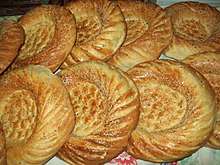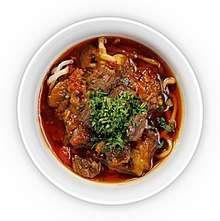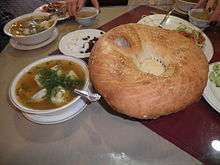Uzbek cuisine
Uzbek cuisine shares the culinary traditions of Turkic peoples across Central Asia.[1] There is a great deal of grain farming in Uzbekistan, so breads and noodles are of importance, and Uzbek cuisine has been characterized as "noodle-rich".[2] Mutton is a popular variety of meat due to the abundance of sheep in the country and it is a part of various Uzbek dishes.

.jpg)
Uzbekistan's signature dish is palov (plov or osh or "pilaf"), a main course typically made with rice, pieces of meat, grated carrots and onions. It is usually cooked in a kazan (or deghi) over an open fire; chickpeas, raisins, barberries, or fruit may be added for variation. Although often prepared at home for family and guests by the head of household or the housewife, palov is made on special occasions by the oshpaz, or the osh master chef, who cooks the national dish over an open flame, sometimes serving up to 1,000 people from a single cauldron on holidays or occasions such as weddings. Oshi nahor, or "morning plov", is served in the early morning (between 6 and 9 am) to large gatherings of guests, typically as part of an ongoing wedding celebration.
Other notable national dishes include: shurpa (shurva or shorva), a soup made of large pieces of fatty meat (usually mutton) and fresh vegetables; norin and lagman, noodle-based dishes that may be served as a soup or a main course; manti (also called qasqoni), chuchvara, and somsa, stuffed pockets of dough served as an appetizer or a main course; dimlama (a meat and vegetable stew) and various kebabs, usually served as a main course.
Green tea is the national hot beverage taken throughout the day; teahouses (chaikhanas) are of cultural importance. Black tea is preferred in Tashkent. Both are typically taken without milk or sugar. Tea always accompanies a meal, but it is also a drink of hospitality, automatically offered green or black to every guest. Ayran, a chilled yogurt drink, is popular in the summer.
The use of alcohol is less widespread than in the West. Uzbekistan has 14 wineries, the oldest and most famous being the Khovrenko Winery in Samarkand (est. 1927). The Samarkand Winery produces a range of dessert wines from local grape varieties: Gulyakandoz, Shirin, Aleatiko, and Kabernet likernoe (literally Cabernet dessert wine in Russian).[3][4] Uzbek wines have received international awards and are exported to Russia and other countries in Central Asia.
The choice of desserts in Uzbek cuisines is limited. A typical festive meal ends with fruit or a compote of fresh or dried fruit, followed by nuts and halvah with green tea.
Bukharan Jewish cuisine
The cooking of Bukharan Jews forms a distinct cuisine within Uzbekistan, subject to the restrictions of Jewish dietary laws.[5] The most typical Bukharan Jewish dish is oshi sabo (also osh savo or osovoh), a "meal in a pot" slowly cooked overnight and eaten hot for Shabbat lunch. Oshi sabo is made with meat, rice, vegetables, and fruit added for a unique sweet and sour taste.[6] By virtue of its culinary function (a hot Shabbat meal in Jewish homes) and ingredients (rice, meat, vegetables cooked together overnight), oshi sabo is a Bukharan version of cholent or hamin.
In addition to oshi sabo, authentic Bukharian Jewish dishes include:[7]
- Osh palov - a Bukharian Jewish version of palov for weekdays, includes both beef and chicken.
- Bakhsh - "green palov", rice with meat or chicken and green herbs (coriander, parsley, dill), exists in two varieties; bakhshi khaltagi cooked Jewish-style in a small bag immersed in a pot with boiling water or soup and bakhshi degi cooked like regular palov in a cauldron;[8] bakhshi khaltagi is precooked and therefore can be served on Shabbat.
- Khalta savo - food cooked in a bag (usually rice and meat, possibly with the addition of dried fruit).[5][9]
- Yakhni - a dish consisting of two kinds of boiled meat (beef and chicken), brought whole to the table and sliced before serving with a little broth and a garnish of boiled vegetables; a main course for Friday night dinner.[5]
- Kov roghan - fried pieces of chicken with fried potatoes piled on top.[10]
- Serkaniz (Sirkoniz) - garlic rice dish, another variation of palov.
- Oshi piyozi - stuffed onion.[8]
- Shulah - a Bukharian-style risotto.
- Boyjon - eggplant puree mixed only with salt and garlic, the traditional starter for the Friday-night meal in Bukharan Jewish homes.[5]
- Slotah Bukhori - a salad made with tomato, cucumber, green onion, cilantro, salt, pepper, and lemon juice. Some also put in lettuce and chili pepper.
- Noni Toki - a crispy flat bread that is baked on the back of a wok. This method creates a bowl shaped bread.
- Fried fish with garlic sauce (for Friday night dinner):[8] "Every Bukharian Sabbath ... is greeted with a dish of fried fish covered with a pounded sauce of garlic and cilantro."[11] In the Bukharan dialect, the dish is called mai birion or in full mai birion ovi sir, where mai birion is fried fish and ovi sir is garlic sauce (literally "garlic water").[5] Bread is sometimes fried and then dipped in the remaining garlic water and is called Noni-sir.
Other Uzbek dishes
- Oshi toki - stuffed grape leaves, similar to dolma, usually served as a cold appetizer.
Breads
.jpg)

Traditional Uzbek bread, called generically noni[12] or patyr, is baked in the form of circular flat loaves (lepyoshka in Russian) with a thin decorated depression at the center and a thicker rim all around. Nons are brought to the table with the decorated side up, then torn into irregular chunks which are stacked on the bread plate. Every region has different varieties of non, most prominent are:
- Obi non is the staple bread of Uzbek cuisine. Obi nons are mentioned in one of the oldest written works, the Epic of Gilgamesh. Obi nons are baked in clay ovens called tandir.
- Samarkand non. In different areas of Uzbekistan, obi non is baked in different ways. In Samarkand, small thick obi nons, the shirma nons are the most popular.
- Bukhara obi non sprinkled with sesame or nigella, making a delicate aroma.
- Wedding patir (flaky obi non) from Andijon and Qashqadaryo. According to ancient traditions, this aromatic bread prepared with cream and butter was served during matchmaking meetings.
- Tashkent lochira, plate-formed obi non, baked from short pastry (milk, butter, and sugar). Jirish non is specially prepared bread from flour mixed with wheat. Nomadic tribes did not make tandirs because of their way of living, but cooked bread on butter in kazans (cauldrons), preparing the dough on a milk base.
See also
- List of Uzbek dishes
- Soviet cuisine
- Karakalpaks cuisine(ru:Каракалпакская кухня)
References
- "Uzbek Food: Festival of Taste". advantour.
- "The noodle-rich cuisine of Uzbekistan", The Village Voice, Dining, 19 January 1999.
- Dessert wines from Uzbekistan Archived 2009-04-02 at the Wayback Machine (in Russian)
- Tokay-style wines from Uzbekistan Archived 2009-02-21 at the Wayback Machine (in Russian)
- Claudia Roden, The Book of Jewish Food: An Odyssey from Samarkand to New York, Alfred Knopf, New York (1996).
- Oshi sabo recipe (in Hebrew); recipe in English from Jewish Woman Archived 2008-09-29 at the Wayback Machine, Fall 2005.
- BJews.com. "Bukharian Jewish Global Portal: Cuisine". Bukharianjews.com. Retrieved 2012-01-05.
- Ethnographic Atlas of Uzbekistan: Central Asian Jews, p. 93 (in Russian)
- Bukharian Jewish practice of cooking in a bag (in Russian)
- Kov roghan recipe and photo in Wiki Cookbook
- "The Silk Road Leads to Queens", Brief culinary history of Central Asia from New York Times, 18 January 2006, accessed 13 September 2008.
- Hansen, Eric (July–August 2015). "The Fabled Flatbreads of Uzbekistan". AramcoWorld.
External links
| Wikimedia Commons has media related to Cuisine of Uzbekistan. |


